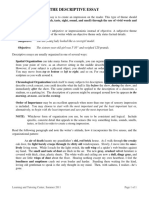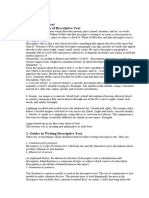0% found this document useful (0 votes)
7 views23 pagesUnit 5. Descriptive Paragraph (Lesson 1)
The document is a lesson on writing descriptive paragraphs, emphasizing the use of sensory details to create vivid imagery for the reader. It covers the definition, organization, and transitional devices essential for effective descriptive writing, along with examples and practice exercises. Key points include the importance of using all five senses and the arrangement of details in spatial order.
Uploaded by
buinhatnguyenCopyright
© © All Rights Reserved
We take content rights seriously. If you suspect this is your content, claim it here.
Available Formats
Download as PPTX, PDF, TXT or read online on Scribd
0% found this document useful (0 votes)
7 views23 pagesUnit 5. Descriptive Paragraph (Lesson 1)
The document is a lesson on writing descriptive paragraphs, emphasizing the use of sensory details to create vivid imagery for the reader. It covers the definition, organization, and transitional devices essential for effective descriptive writing, along with examples and practice exercises. Key points include the importance of using all five senses and the arrangement of details in spatial order.
Uploaded by
buinhatnguyenCopyright
© © All Rights Reserved
We take content rights seriously. If you suspect this is your content, claim it here.
Available Formats
Download as PPTX, PDF, TXT or read online on Scribd
/ 23




























































































